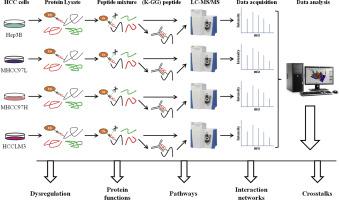Journal of Proteomics ( IF 2.8 ) Pub Date : 2020-05-23 , DOI: 10.1016/j.jprot.2020.103834 Ying Sun 1 , Xiaoyuan Zheng 2 , Hui Yuan 2 , Geng Chen 2 , Jiahe Ouyang 2 , Jingfeng Liu 1 , Xiaolong Liu 1 , Xiaohua Xing 3 , Bixing Zhao 2

|
Hepatocellular carcinoma (HCC) is one of the most common malignant tumours, metastasis and recurrence remain the primary reasons for poor prognosis. Ubiquitination serves as a degradation mechanism of proteins, but it is involved in additional cellular processes including metastasis. Here, by using label-free quantification, double-glycine (di-Gly) antibody affinity purification and high-resolution liquid chromatography tandem mass spectrometry (LC-MS/MS), we investigated quantitative proteome, ubiquitylome, and the crosstalk between the two datasets in HCC cell lines with different metastasis potential to identify biomarkers associated with HCC metastasis. In total, 83 ubiquitinated proteins significantly and steadily changed their abundance according to their metastatic potential, and the participated biological processes of these ubiquitinated proteins were tightly associated with tumour metastasis. Further signaling pathway analysis revealed that the ribosome and proteasome were significantly over-activated in the highly metastatic cells. Furthermore, we analyzed the crosstalk between the whole proteome and the ubiquitylome, and further discussed the mechanism that how ubiquitination events affect HCC metastasis. Eventually, the ubiquitination of Ku80 was validated to be significantly down-regulated in the high-metastatic cells comparing with the low-metastatic cells. We believe that these findings will help us better understand the underlying molecular mechanisms of the metastasis of HCC.
Significance
In this manuscript, we used label free based proteomics combined with diglycine antibody (di-Gly) affinity purification approach to identify biomarkers associated with HCC recurrence/metastasis in in a serial HCC cell lines with increasing invasion and metastasis potential. And then, we analyzed the crosstalk between the whole proteome and the ubiquitylome. Eventually, the ubiquitination of Ku80 was confirm to be closely associated with invasion and migration of HCC cells. As far as we know, this is the first time to use quantitative proteomic approach to study the ubiquitylomics in HCC cell lines with increasing metastasis ability.
中文翻译:

蛋白质组学分析揭示了具有不同转移潜能的肝细胞癌细胞系中的泛素化模式存在差异。
肝细胞癌(HCC)是最常见的恶性肿瘤之一,转移和复发仍然是预后不良的主要原因。泛素化充当蛋白质的降解机制,但它参与包括转移在内的其他细胞过程。在这里,通过使用无标记定量,双甘氨酸(di-Gly)抗体亲和纯化和高分辨率液相色谱串联质谱(LC-MS / MS),我们研究了定量蛋白质组,泛素组和两者之间的串扰具有不同转移潜力的HCC细胞系中的数据集,以鉴定与HCC转移相关的生物标志物。共有83种泛素化蛋白质根据其转移潜能显着且稳定地改变了其丰度,这些泛素化蛋白参与的生物学过程与肿瘤转移密切相关。进一步的信号通路分析表明,核糖体和蛋白酶体在高度转移性细胞中明显过度活化。此外,我们分析了整个蛋白质组和泛素化组之间的串扰,并进一步讨论了泛素化事件如何影响HCC转移的机制。最终,证实了Ku80的泛素化在高转移细胞中与低转移细胞相比被显着下调。我们相信这些发现将帮助我们更好地了解肝癌转移的潜在分子机制。进一步的信号通路分析表明,核糖体和蛋白酶体在高度转移性细胞中明显过度活化。此外,我们分析了整个蛋白质组和泛素化组之间的串扰,并进一步讨论了泛素化事件如何影响HCC转移的机制。最终,与低转移细胞相比,Ku80的泛素化被证实在高转移细胞中显着下调。我们相信这些发现将帮助我们更好地了解肝癌转移的潜在分子机制。进一步的信号通路分析表明,核糖体和蛋白酶体在高度转移性细胞中明显过度活化。此外,我们分析了整个蛋白质组和泛素化组之间的串扰,并进一步讨论了泛素化事件如何影响HCC转移的机制。最终,与低转移细胞相比,Ku80的泛素化被证实在高转移细胞中显着下调。我们相信这些发现将帮助我们更好地了解肝癌转移的潜在分子机制。经证实,与低转移细胞相比,Ku80的泛素化在高转移细胞中显着下调。我们相信这些发现将帮助我们更好地了解肝癌转移的潜在分子机制。经证实,与低转移细胞相比,Ku80的泛素化在高转移细胞中显着下调。我们相信这些发现将有助于我们更好地了解肝癌转移的潜在分子机制。
意义
在本手稿中,我们使用了基于无标签的蛋白质组学结合双甘氨酸抗体(di-Gly)亲和纯化方法,以鉴定与侵袭和转移潜能增加的HCC细胞系中HCC复发/转移相关的生物标志物。然后,我们分析了整个蛋白质组与泛素组之间的串扰。最终,Ku80的泛素化被证实与HCC细胞的侵袭和迁移密切相关。据我们所知,这是首次使用定量蛋白质组学方法研究具有增强转移能力的HCC细胞系中的泛素化。











































 京公网安备 11010802027423号
京公网安备 11010802027423号